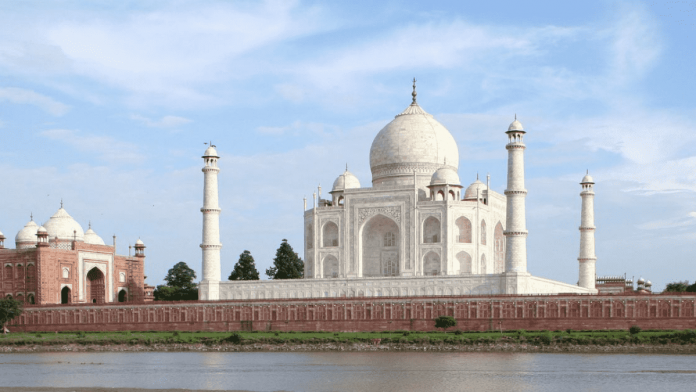Here, we’ll discuss about some very interesting facts of Uttar Pradesh including the culture, history, economy, geography, polity, education system, etc.
Do you know which state is known as the “Sugar Bowl of India“? Which Holy River flows through this state? Which state was rewarded with Hinduism’s twin Sanskrit epics, Ramayana and Mahabharata?
All these questions along with many others will be answered in this particular blog. So let’s get started.
UTTAR PRADESH (UP) has had a long history of language, culture and literature. The sheer variety and richness of the astonishing contribution of literary figures from Uttar Pradesh dates back to the ancient days. Before proceeding, let’s look at the state specialty/symbol –
Table of Contents
State Symbols
| State Capital | Lucknow |
| State Flower | Palash (Butea Monosperma or Brahm Kamal) |
| State Tree | Ashoka (Saraca Asoca) |
| State Animal | Barasingha (swamp deer) |
| State Bird | Sarus Crane |
| State Dance | Kathak |
| State Chief Minister (Present) | Shri. Yogi Adityanath |
| State Governor (Present) | Mrs. Anandi Ben Patel |
CULTURE
The cultural aspect of UP is distinct from other states and that’s what makes it “Best from the Rest”. The state also has a plethora of fairs and festivals that add to the charm and charisma of the state.
- UP is the place where Kathak, one of the eight foremost classical dances of India, flourished. The word “Katha” from which the name derived means Story.
- Ramlila is one such art from dealing with the life of Lord Rama.
- Braj Raslila is associated with the life of the lover God- Lord Krishna.
- Charkula is another folk dance of the state.
- Varanasi/Banaras/Kashi, also known as “The City of Temples” is the oldest city in India. The city has 88 Ghats.
- The Brocades and Silk of Banaras are famous across the globe.
- Taj Mahal, the UNESCO World Heritage Site is situated on the South Bank of the river Yamuna in the city of Agra. It was commissioned in 1632 by the Mughal Emperor, Shah Jahan, to house the tomb of his favourite wife, Mumtaz Mahal. It is one of the 8 Wonders of the World.
- Agra Durries are very famous.
- HINDI is the sole language of UP and is spoken by the majority of the population. However, URDU is given the status of second language.
- Allahabad or Prayagraj is the world-renowned Sangam, the confluence of three holy rivers Ganga, Yamuna and Saraswati.
- UP is home to a variety of cuisines, most famous of which are Awadhi cuisines and Mughal cuisines, very popular in Lucknow.
- Other than the national festivals like Holi, Diwali and Makar Sankranti, Bharat Milap and Chhath Pooja is supposed to be a big affair in Varanasi and it attracts tourists from all over the country.
- The traditional dress of the women of UP is a sari and a blouse or salwar kameez. They also adorn themselves in accessories including gold chains, necklaces, rings, bangles, trinkets, tiaras and anklets. The men opt for dhoti kurta or kurta pyjama.
Let’s start with the next aspect i.e.
GEOGRAPHY
Uttar Pradesh is a frontier state located in the north-central part of India
- Latitudinal extension- 23.52′ to 30.24′ northern latitude
Longitudinal extension- 77.05′ to 84.38′ east longitude
From east to west, its length is 650 km and from south to north is 240 km.
- Area– 2,43,286 sq.km (7.33% of the total area of India)
It is the Fourth largest state of India in terms of area percentage
(After Rajasthan, Madhya Pradesh and Maharashtra respectively).
- Forest area is 640 sq mi i.e. 6.86 % of the total area of UP.
- Border line– The boundary of UP touches 8 States and one Union Territory along with one country i.e. Nepal
NEIGHBOURING STATES-
North- West: Uttarakhand and Himachal Pradesh
West: Haryana and Rajasthan
South: Madhya Pradesh
East: Bihar
South-East: Jharkhand and Chhattisgarh
- NEIGHBOURING UT-
In North-West: Delhi
(The largest border touching UP is that of Madhya Pradesh whereas the smallest border touching is Himachal Pradesh.)
- Population- 199,812,341
Rank in India (Population wise) – First
Climate-
The climate of UP is predominantly Tropical Monsoon type. However, due to the different abnormalities and different heights of different places from the sea level, there is an inequality in the climate. The three seasons found are: Summer, Rainy and winter.
- Summer Season- This season extends from Mid-March to Mid-June. The average high temperature is 36°C to 39°C whereas the average low temperature is 21°C to 23°C. The highest average temperature is found in Bundelkhand. The reason for this is its position near the line of the Tropic of Cancer.
- Rainy Season- This season extends from the last week of June to October. Highest rainfall occurs in the months of July and August. Average temperature ranges from the maximum of 32°C to 34°C and a minimum of 25°C. The districts with highest and lowest rainfall are Gorakhpur (184.7 cm) and Mathura (54.4 cm) respectively.
- Winter Season- This season extends from November to February. The coldest month of this season is January.
Terrain and Soil-
If we talk about the nature of soil of UP, its Alluvial Soil which is most widely spread.
- The soil of Bhabar-Terai region is made up of stones and thick sand. Whereas the soil of alluvial soil has been formed from mud and sand.
- Alluvial soil is rich in Potash and Lime.
- Desert soil is found in some western parts of the state. Lal, Parva, Mar, Rakar, etc. soils are found in Bundelkhand area.
- The percentage of the wetland area is, in terms of total area of the states is 5.15%.
- Sonabhadra is the district of UP with highest wetland area. Baghpat and Mathura are the districts of UP with lowest wetland area.
Physiographic areas-
UP is currently divided into three physiographic areas-
- Gangetic Plain- The elevation of Ganga Yamuna is 300 metres from sea level. It has been constructed from alluvial soil.
- Bhabar-Terai region – This area extends from Saharanpur in the North- West to Kushinagar in the east. Swamp field is found here due to excessive rainfall.
- Plateau of the south- The total area of this area is 45200 sq km. The terrain of Bundelkhand and Baghelkhand is included in the plateau region of the south.
Another aspect for understanding the state UP is to understand its POLITICAL STRUCTURE.
POLITICAL STRUCTURE-
Under the Government of India, 1935, a bicameral legislature and set up with a legislative assembly and a legislative council.
The state has a bicameral legislature also called Vidhan Bhawan located in Lucknow, with two houses- the lower and the upper house.
- The lower house is the Vidhan Sabha or the State Legislative Assembly.
- The Upper house is the Vidhan Parishad or the State Legislative Council.
The Vidhan Sabha consists of 403 directly elected members for five- year term and one Anglo- Indian member who is nominated by the Governor. It can be dissolved. On the other hand, the Vidhan Parishad is a permanent body of 100 members with one-third (33 members) retiring every two years. It cannot be dissolved.
Representation of UP in Parliament–
Rajya Sabha- 31
Lok Sabha- 80
Do you know who was the first CM and the first Governor of UP?
Governors-
The First Governor of United Provinces- Sir Spencer Harcourt Butler (3 January 1921- 21 December 1922)
First Governor of United Provinces (After Independence) – Sarojini Naidu (15 August 1947- 2 March 1949)
The First Governor of UP – Hormasji Peroshaw Mody (26 January 1950 – 1 June 1952)
Chief Ministers-
CM of UP after its existence- Govind Ballabh Pant (26 January – 20 May 1952)
Here are Some Interesting Facts about UP which make it exceptionally outstanding –
- A Raza Library in Rampur depicts Gurdwara, Church, Mandir and Masjid all together.
- Well known for its Kumbh Mela – four pairs are held periodically at one of the following places by rotation in Haridwar, Prayagraj, Nashik and Ujjain. The Kumbh Mela is held once in 12 years.
- Whereas the Ardh Kumbh Mela occurs every 6 years between two Purna Kumbh Melas at Allahabad and Haridwar. The 2019 Ardh Kumbh Mela was held at Triveni Sangam in Prayagraj.
- Famous as Hindi Heartland as it gave a number of notable writers to Hindi literature like Saint Kabirdas, Tulsidas, Surdas, Premchand, etc.
Conclusion
Hope this blog was helpful in clearing your doubts regarding this beautiful state.
Do you know about the economy of Uttar Pradesh as compared to other states and the famous places and speciality of this State? So just be ready for the next blog in which we’ll be telling you about the Culture, Economy, Sports, Environment and much more. If you don’t want to miss it, click here – Know your State ‘Uttar Pradesh’ – Part 2.
We hope that this topic will be favourable for you in exams such as SSC CGL, RRB NTPC, CDS, etc.
Thank You




